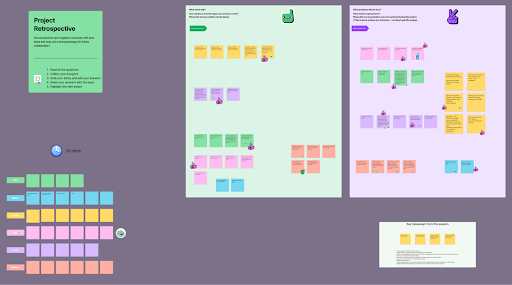Contents
Several UX projects require teamwork. As individuals (researchers or designers), we can be the best employees, highly skilled, and the best in our field, but a UX project usually requires collaboration. However, simply putting together a group of well-qualified professionals does not inherently guarantee success. To make a teamwork dream work, several factors must be considered. Read further if you are interested in how to create a smooth and effective collaboration.

Establishing and maintaining an effective collaboration within a team takes almost as much effort as your professional tasks. But, since we always try to focus on the visible result, we tend to forget to pay attention to other factors that also contribute to the best outcome. It is important to remember – creating a motivating environment fosters productive collaboration and boosts creativity.
In a very recent article, we talked about the social aspect of collaboration and its impact on creating a motivating environment. In this blog post, you’ll find a short guide that walks you through the other most important steps that contribute to effective teamwork.
Take The Other’s Perspective Into Account
Perspective-taking helps us understand a situation from different points of view. It reduces conflicts, facilitates communication, and helps us to see the big picture. Besides these explicit outcomes, perspective-taking also has some unconscious effects that can be beneficial. For example, taking others’ perspectives fosters creative problem-solving and increases positive emotions that contribute to high-quality work. It also helps you notice more of that person in yourself, which eventually reduces the propensity of judgments (for further information, check this article).
If you work as a designer or researcher, you are usually part of a product team, which is fundamentally a collaborative process. In such teams, taking into account the opinions and backgrounds of others is an indispensable step towards a smooth collaboration.

Taking someone else’s perspective into account sounds very easy, but doing it properly can be very difficult. Here are some tips on how to do it:
- 1 – Take a short break – the whole session lasts around 30 minutes. Lay back and take a deep breath. When breathing in, think about positive things. When breathing out, release all negative feelings and vibes. Repeat this until you feel relaxed.
- 2 – Imagine the situation that upset you, but now observe it like an outsider. Replay in your mind what happened and try to answer the following questions: What knowledge did each participant have, including yourself? What could be the most important to each person? What concerns or pain points did each of them have? This step helps you look at the problem from different perspectives and gain insights into the motivations and emotions of everyone involved.
- 3 – Answering the questions of step 2 is only the beginning of this journey. Spend some time with this mindset. Think about – even better if you write down bullet points – how the problem/situation looks different now. Why could each person behave the way they did? This step can help you develop empathy and understanding for others, leading to more effective communication and collaboration.
Remember, the most challenging part of this process is focusing only on the other person’s point of view and suppressing your own feelings. Find a suitable time when you are in the right mood for this whole session. But remember: postponing it can make the whole process harder – as memories fade over time, making accurate recall less feasible.
Be Flexible
If things are going according to your predefined plan, great job! You can skip this section. 😉
However, it’s also possible that things may not go as planned. There can be countless reasons for this, but now let’s focus on how to adapt to a situation like that.

Flexibility is a key characteristic of any team player. However, throughout a collaboration or project, many obstacles and unexpected hurdles can come up that you as a team have to solve and you as an individual have to adapt to. So what can you do?
- 1 – Open communication
Proper communication is essential for being able to flexibly adapt to changes. It lets everyone understand the ‘big picture’- what changes are happening and why. Express your ideas, thoughts, and concerns, and encourage your colleagues to do the same. If you disagree with something or are unsure about what is happening, don’t be afraid to ask questions! You can only adapt to changes if you understand the decisions that have been made and also their background. To avoid giving the impression that you are questioning the decision itself, formulate your questions properly. Another paragraph in this article provides some tips on how to do that by covering assertive communication in more detail.
- 2 – Be open-minded!
Being receptive to new ideas and experiences is an essential skill to flexibly adapt to changes. Listen to and consider what other people are saying without judging. First, hear what they are saying, and understand their point of view. And if you have concerns, try to challenge their approaches by asking questions and seeking further information. Of course, you don’t necessarily have to agree with the new ideas, but putting effort into at least understanding them can also help you to persuade them to change their thoughts, and you might come up with a better solution together.
- 3 – Be curious and open to learning new skills.
Changes can bring uncertainty – when things don’t go as planned, the situation can become unpredictable. Questions may arise, such as: What will the new setup look like? What tasks will I have? What if this approach fails again? The more knowledge and skills you possess, the better equipped you will be to deal with unexpected situations and tasks. Following the industry trends and innovations, broadening your knowledge will help you be flexible and adapt to changes quickly.
By communicating effectively, being open-minded, and learning new skills, team members can better navigate unexpected hurdles, solve problems, and work together towards a common goal.
Give and Ask for Feedback
Both giving and receiving feedback can be challenging and, at times, uncomfortable. However, it is essential for building successful teamwork. Remember that feedback is not inherently negative but rather an opportunity to get to know each other’s perspectives and see things from different points of view.

The key to successful feedback is in the “how.” The way you provide valuable and constructive feedback to others often matters more than the actual content of the feedback itself. You might highlight valuable points, but if it creates negative feelings in the receivers, they may not accept it or build it in. To ensure that feedback is useful and productive, it is essential to follow a few guidelines. Let’s take a look at some tips:
- 1 – Organize: Whenever you feel your team needs a feedback session, bring up the idea, and explain why you think it would be beneficial. Then, try to schedule an appointment when everyone is available. A feedback session shouldn’t be longer than 1-1,5 hours.
- 2 – Define: Before the session, think through (and preferably write down) what you want to discuss and why. Identify your main goal for the feedback and what you hope to achieve with it.
- 3 – “Build up” the feedback: Many people still believe in the so-called “sandwich” technique: wrapping negative feedback in between positive feedback. It involves starting with some good things, then addressing the important negative points, and at the end, saying some positive things again. The downside of this technique is that the information “hidden” in the middle may be easily overlooked.
- 4 – Give room to others: Remember, a feedback session is not just about sharing your own thoughts. Always provide others with the opportunity to share their perspective and feelings. A feedback session should be a conversation between all parties involved.
- 5 – Prepare: Prepare for the session in advance by collecting topics, problems, and questions you would like to cover. Create a board with the goal of the session and the defined topics using tools like Miro, Figjam, or any other tool your team is comfortable with. Leave space or post-its for each topic to allow participants to share their thoughts during the session. (Check out a feedback session template created in Figjam below.)

- 6 – Facilitate: Start the session by highlighting its goal. Then, go through each topic one by one. Always leave a certain amount of time for the participants to think through each topic and write down their thoughts. When the allotted time is up, provide space for everyone to explain their opinions and ask clarifying questions if necessary.
- 7 – Summarize: At the end of the session, summarize the key learnings, and what should be done the same way or differently in the future.
Feedback sessions are not only great because you can learn from them, but they also have additional positive consequences. Studies have demonstrated that a well-prepared feedback session can increase performance levels, support individuals in achieving their goals, and boost personal engagement.
Communicate Assertively
When communicating with colleagues, clients, or stakeholders, it’s important to be mindful of both what you say and how you say it. Endeavor to communicate assertively, which means explaining things directly and clearly while also actively listening to others. The most important part of it is that you have to stand up for your rights and needs in a manner that makes you seem brave and confident but not arrogant and aggressive. To achieve this balance, there are some principles that you can follow.
Principles:
- 1 – Follow the basic non-verbal communication rules that help you look confident (e.g., direct eye contact, balanced posture, medium tone, and volume of voice).
- 2 – Explain everything carefully, keeping in mind that what is clear for you may not be clear for someone else.
- 3 – Take breaks and let the receiver respond and/or ask questions at certain points. If they don’t ask questions, try to encourage them to do so by asking for their opinions and thoughts.
- 4 – Support the objective observations with facts, and in the case of subjective ones, emphasize that those are only your opinions.

Being able to communicate assertively takes time and practice, but it will definitely help you to be heard and understood in any workplace setting.
Be Patient and Educate Whenever Needed
As UX professionals, we often encounter challenges with team members who are not familiar with UX processes and have misconceptions about what we do. These misconceptions stem from a lack of understanding rather than ill will. People outside of UX may not grasp the importance of certain steps or want to rush through them. For instance, wireframing and building a design system are essential steps that may seem unnecessary to others, but they actually help save money in the long run. Likewise, feedback from a look-and-feel workshop is crucial for us to move forward, but team members may claim they are too busy to participate. These misunderstandings and points of friction can be frustrating and cause tension. Education can help overcome these issues.
- Explain and educate:
If you feel the client or your colleagues don’t fully understand your goal or approach, try to calmly explain it to them. Tell them why it is important at that specific stage, why it takes a certain amount of time, and what might happen if they miss that step. Bring relevant examples from your previous experiences to illustrate your points. Remember that some details may be clear to you but not to others. Also, let them explain their concerns or fears and why they are reluctant to follow that plan. Answer any questions that may arise and address their concerns to ensure everyone is on the same page.
- Be open to trade-offs:
It may occur that even after lengthy discussions and education, team members still hesitate. At that point, you must decide how far to push your approach and when to offer an alternative solution. This decision depends on many factors. However, a never-ending fight within the team can be destructive and toxic. Therefore, after a few days or weeks, it is essential to make a decision and move forward.
Education, clear and detailed explanations, examples, and answering all questions seem like tiny things, but doing them properly always takes time. Be sure to dedicate enough time to them, and try to share all the information that would help you get you all on the same page.
To successfully educate others, you will need all previously mentioned soft skills: taking others’ perspectives, being flexible, giving and receiving proper feedback, and communicating assertively. All these skills are closely related to each other, and putting effort into enhancing them contributes highly to making a teamwork dream work.

What Is The Key Takeaway Here?
Collaborating smoothly with people of different backgrounds and personalities can be challenging. Often, we focus solely on achieving set goals quickly and neglect the fact that team members can be more committed and efficient if they truly form a team rather than just individuals who work together. To foster successful collaboration in UX projects, a holistic approach is required that extends beyond individual expertise.
In essence, true collaboration arises from a symphony of soft skills, where team members genuinely engage with each other’s perspectives, communicate openly, and remain adaptable. By valuing these aspects, a UX project can transform from a collection of skills to a true teamwork dream.
Searching for the right UX agency?
UX studio works with rising startups and established tech giants worldwide.
Should you want to improve the design and performance of your digital product, message us to book a consultation with us. We will walk you through our design processes and suggest the next steps!
Our experts would be happy to assist with the UX strategy, product and user research, or UX/UI design.




